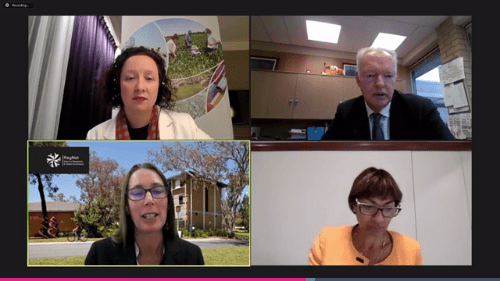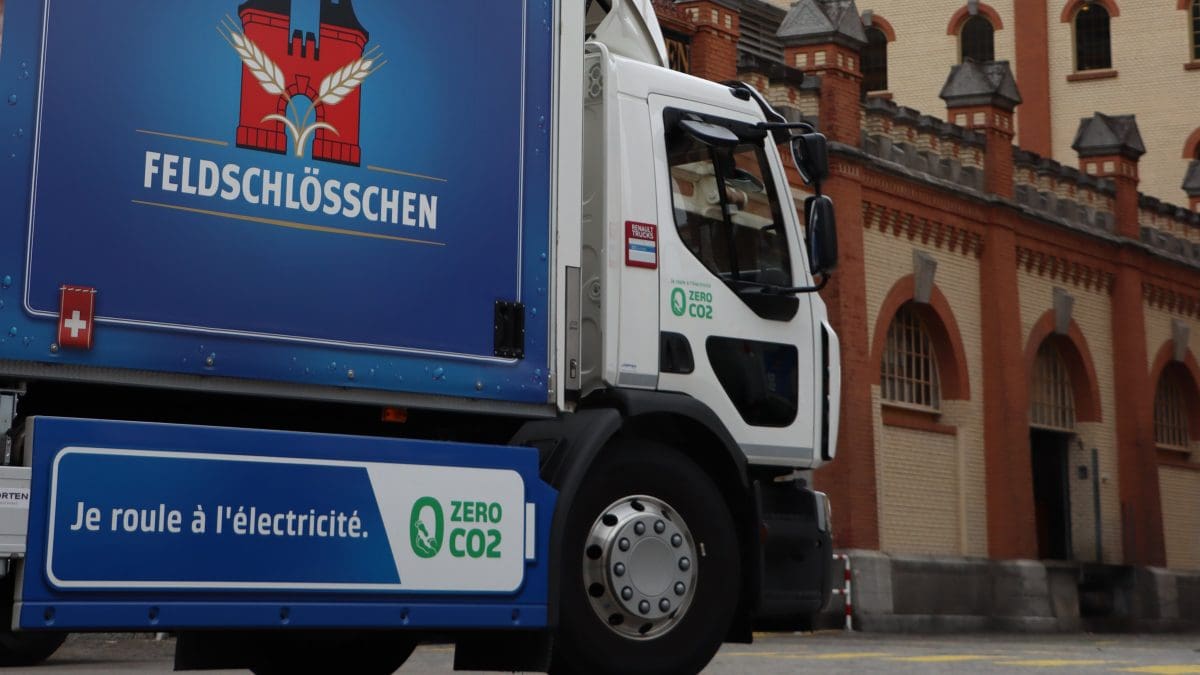
Session chair and Minister-Counsellor Agriculture to the EU, Jo Grainger, Cornelis Keijzer, Emma Aisbett (bottom left) and Su McCluskey discuss greener trade at ABARES Outlook 2022.
AUSTRALIAN producers are well-placed to meet sustainability standards growing in prominence as climate policies start to steer some global agricultural markets.
That was the message from Australian National University researcher Emma Aisbett, one of three speakers who last week addressed the ABARES Outlook 2022 session entitled Trading in a greener environment – can Australia’s agricultural exports maintain competitive advantage?
Many Australian grain producers already grow canola and barley under Sustainable Grain Australia standards which meet the International Sustainability & Carbon Certification Scheme (ISCC).
Along with multinational companies’ net zero supply-chain commitments, Dr Aisbett said ISCC was an example of a private and multi-stakeholder initiative reshaping trade.
“Australian farmers can really profit from these changes.”
“I think it’s really important to remember that this actually is a huge opportunity for Australian agriculture.”
However, Dr Aisbett said improvement was needed in two key areas to keep Australia ahead of the game: emissions in shipping, and the regulatory burden imposed on producers.
“Although Australian agriculture actually can meet the green standards, it’s difficult or costly…to prove that,” Dr Aisbett said.
Dr Aisbett said it was important that proving environmental compliance was not more complicated for Australian farmers than it was for EU farmers for example, as increased climate-change ambition drives trade-related climate policy for some of Australia’s export markets.
“If the government and the research community take on the burden of figuring out those complexities, then they can deliver something that is not too complex to the producers.
“That lets them get on with the job of feeding us all and helping save us from climate change.”
She said producers should ideally be able to enter one lot of information that gave them access to multiple markets for multiple commodities.
Freight of concern
Dr Aisbett said Australia’s distance from Europe and other discerning markets was a headwind its exports may encounter.
“The tyranny of distance could strike again, if food miles mean our products are less environmentally sound.”
However, Dr Aisbett said the use of fuels including green hydrogen could abate that as change starts to occur in land, sea and air transport.
“We are now seeing the development of zero-emission transport systems.
“All of these things can help decarbonise our supply chain to get to those lucrative international markets.
Dr Aisbett said she was part of the research community in Australia involved in Diplomacy 2.0, or dialogue between industry and research that could aid trade negotiations, and was already working with Germany on developing a green-hydrogen export market.
She said this level of “nitty-gritty detail” that can be discussed in Diplomacy 2.0 was helpful in developing markets, as was Diplomacy 1.5, where government has dialogue with industry and research.
Europe a driver
The EU is Australia’s largest market by far for canola, all grown to ISCC standards, and crushed to produce oil for use as biodiesel.
EU policy, as well as EU-based companies including global brewers like Carlsberg and Heineken, have been major drivers of the shift to sustainability-accredited farming globally.

One of the electric trucks in the Carlsberg-owned fleet in Switzerland. Photo: Carlsberg Group
EU Delegation in Australia head of trade and economics Cornelis Keijzer told the Outlook forum that EU’s Carbon Border Adjustment Mechanism (CBAM) would not apply to agricultural products, which includes red meat and canola.
This has allayed the fears of some Australian exporters, who feared CBAM would ratchet up the price of canola, meat and other agricultural products.
CBAM applies to imported iron, steel, cement, fertiliser, aluminium, and electricity generation, and Mr Keijzer said these accounted for only around 0.25 per cent of Australian exports to the EU.
“Those are very small part of exports from Australia,” Mr Keijzer said.
“It is not a protectionist device; it is to realise our goals on climate change.”
Proposed in July 2021 by the European Commission, he said CBAM would put a carbon price on imports to prevent pushing carbon-intensive production outside the EU.
It does this by requiring EU importers to buy carbon certificates against the carbon price payable in the EU.
“It will not apply to agricultural products, and I cannot see it will be applied any time in the near future.”
Mr Keijzer said Australian agricultural products, including hormone-free beef, were already well regarded in the EU for high health and purity standards.
“Australia can actually have a competitive advantage in this.
“What competitor is better placed than Australia to introduce higher food standards?
He said the EU was facing challenges in its food systems, and aimed to move to a circular bio-based economy.
“We need healthier diets…, to improve animal welfare, and social rights of workers in the food chain, and to keep food affordable.”
“To achieve these sustainability goals, we are engaging with like-minded countries.”
On the production side, he said the EU’s targets for 2030 included a halving of use of chemical pesticides, at least halving nutrient losses, and reduced use of antimicrobials in farmed animals and aquaculture.
“We’ve already reduced the use of pesticides by 20pc from 2012 to 2017.”
He said the EU also aimed to lift the amount of organic land as a proportion of total farmland to 25pc.
Product in demand
Last year, Su McCluskey was appointed as the Federal Government’s first Special Representative for Australian Agriculture.
The role was introduced to help boost Australia’s access to export markets, and works with industry, research organisations and governments to promote Australia as a sustainable and innovative producer.
“Of course, Australian has a great story to tell,” Ms McCluskey said in her address to the session.
“Our sustainability credentials are there; the question is: How can we demonstrate that?”
She said the use of minimum or no-till cropping by 95pc of Australian farmers was one example of natural-resource management, with fencing off riparian areas, and destocking in drought being others.
Ms McCluskey said the CSIRO report released last month showed Australian grain production exhibited less greenhouse gas emissions than the EU, US, Canada, Russia and Ukraine.
Some countries, including Japan with its Green Food System Strategy, the European Union with its Farm to Fork Strategy, and the Singapore Green Plan are extending the call to countries like Australia for sustainably produced agricultural exports.
“Right now we see a growing demand (for goods) that can be high welfare and environmentally sustainable.”
Already gaining ground
Dr Aisbett said Australia was already a leader in international carbon markets, particularly at a regional level.
“The Australian Government is actively looking into the Indo-Pacific carbon offset scheme and has recently asked the Climate Change Authority to deliver some really timely work on development of this scheme.”
Dr Aisbett said woody plantings, the improvement of “notoriously carbon-poor soils”, and the incorporation of renewable energy such as solar panels over dams and irrigation channels could all further reduce Australia’s agriculture’s carbon footprint.
“We have world-best opportunities to combine farming with solar and wind, so-called agrivoltaics.”

HAVE YOUR SAY